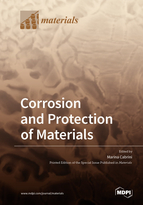Corrosion and Protection of Materials
A special issue of Materials (ISSN 1996-1944). This special issue belongs to the section "Corrosion".
Deadline for manuscript submissions: closed (30 September 2020) | Viewed by 96285
Special Issue Editor
Interests: electrochemical and corrosion; environmentally assisted cracking; hydrogen diffusion and embrittlement; corrosion of additive manufactured alloys; biomaterials
Special Issues, Collections and Topics in MDPI journals
Special Issue Information
Dear Colleagues,
Corrosion is the deterioration of metals in contact with the specific environment, leading to relevant effects on asset safety and maintenance. The first estimation of the economic impact of materials corrosion and protection was carried out in the 1970s by the British Government, with the conclusion that the amount of expenses for the restoration of the damaged structures was around 3% of the Gross Domestic Product (GPD). It is notable that 90% of these expenses would have been easily saved by simply applying the basic know-how concepts of protection and materials selection. Similar studies carried out by the National Association of Corrosion Engineering (NACE) in 2013—more than 40 years later—surprisingly evidenced a similar value, equal to 3.4%. Thus, the economic impact of materials corrosion has constantly increased as the GDP has grown during the years. On the basis of these considerations, it can be concluded that the application of corrosion prevention strategies must be improved, which entails a transition from the corrosion mechanism to in-field applications. In addition—mainly in recent years—materials have been pushed close to their operational limits, i.e., in the exploitation of very deep oil fields. As a consequence, much effort has been applied to the research of better-performing materials, which are able also to reduce energy consumption and environmental impact. In this respect, it is possible to improve the service life of structures and to reduce the energy impact of production plants and the contamination of the environment.
New materials and technologies (high-entropy alloys, ultra-fine-grained metals, innovative smart coatings, new joining technologies, and additive manufacturing) surely open new outlooks in the corrosion science and engineering panorama, which is moving from well-consolidated knowledge towards exciting new challenges.
The aim of this Special Issue is to give an updated outlook of the main corrosion-protection topics regarding both traditional and innovative materials.
Full papers, communications, and reviews reporting the results of more traditional tests based on weight loss or electrochemical techniques as well as more innovative local corrosion techniques (microcell, SKPFM, etc.) and failure analysis are expected.
Prof. Dr. Marina Cabrini
Guest Editor
Manuscript Submission Information
Manuscripts should be submitted online at www.mdpi.com by registering and logging in to this website. Once you are registered, click here to go to the submission form. Manuscripts can be submitted until the deadline. All submissions that pass pre-check are peer-reviewed. Accepted papers will be published continuously in the journal (as soon as accepted) and will be listed together on the special issue website. Research articles, review articles as well as short communications are invited. For planned papers, a title and short abstract (about 100 words) can be sent to the Editorial Office for announcement on this website.
Submitted manuscripts should not have been published previously, nor be under consideration for publication elsewhere (except conference proceedings papers). All manuscripts are thoroughly refereed through a single-blind peer-review process. A guide for authors and other relevant information for submission of manuscripts is available on the Instructions for Authors page. Materials is an international peer-reviewed open access semimonthly journal published by MDPI.
Please visit the Instructions for Authors page before submitting a manuscript. The Article Processing Charge (APC) for publication in this open access journal is 2600 CHF (Swiss Francs). Submitted papers should be well formatted and use good English. Authors may use MDPI's English editing service prior to publication or during author revisions.
Keywords
- Electrochemical techniques to study corrosion
- Localized corrosion of passive materials
- Corrosion of innovative alloys
- Corrosion of rebar in concrete
- Corrosion in oil and gas industry







